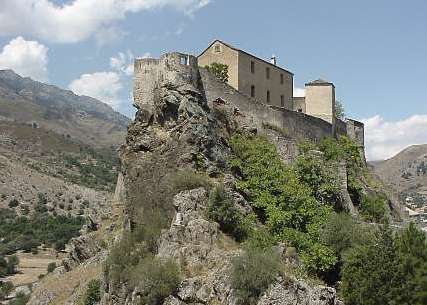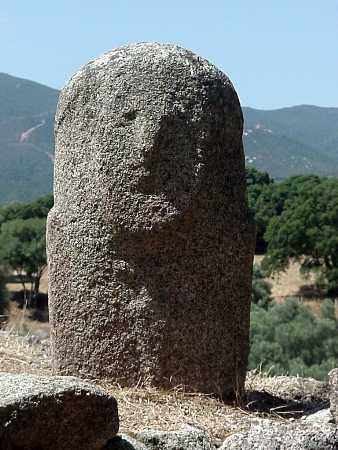 |
 |
 |
 |
Corsica's protected harbors and strategic location made it a target for conquerors and pirates during its long history, ruled by Greeks, Romans, Vandals, Lombards, and Saracens. Later rulers included Pisans, Genoese, and a brief period of independence until finally the island was under the French flag. Saracen pirates from North Africa were a problem for the Genoese in the fifteenth century, attacking the villages and making off with any valuables they found, including people they could hold for ransom or sell as slaves. In response, the Genoese erected more than ninety torri, or watchtowers, at strategic places on the island. The watchmen, or torregiani, would signal the approach of unexpected ships by lighting a fire at the top of the tower. The next tower would see the signal and light its own fire, and the whole island would be alerted within an hour. The pirates stopped being a problem soon thereafter, but the towers were useful for hundreds of years. The British, impressed with the idea, erected their own towers on the south coast of England and Ireland, and used them as lookout posts as late as World War II. |
|
There are nearly 1000 kilometers (about 600 miles) of marked hiking trails in Corsica. The most famous is the 200 kilometer (125 mile) GR20, which crosses the island diagonally and covers much of Corsica's most spectacular scenery. Normally completed in ten to twelve days, only a third of the hikers that begin it complete all sixteen stages, and nobody but the very fit would think of beginning. With steep ascents and descents, the trail is complicated by fickle weather, including intense midday summer heat, violent storms, and possible snowstorms as late as June. Besides carrying food and water for several days, hikers need to carry clothes for all extremes of weather. We chose instead to take a train from coastal Ajaccio to the inland mountain city of Corte, riding on a single track through the mountains, seeing the interior of the island in comfort. |
 |
 |
A man named Charles-Antoine Cesari was inspecting his land at the site of Filitosa in 1946 when he discovered a pile of forgotten menhirs, monolithic statues with carved faces, probably dating from around 3000 BC. Further excavation with the help of an archeologist uncovered early Neolithic shelters under large, eroded rocks and tools made of black volcanic rock, signifying that they were already trading with other societies, perhaps with nearby Sardinia. The photo at left is of statue-menhir Filitosa XIII. You can see clearly the face and chin, carved using rudimentary tools and water. Theories as to the purpose of the statues range from objects of worship, to depictions of the deceased as memorials, to images of conquered attackers intended to frighten off those who might fear the same fate. The last theory is substantiated by the fact that the weapons carved onto the bodies depicted match those of nearby civilizations, not the people of Filitosa or its surroundings. |
|
|
|
 |
|
|
After we saw Corsica's granite mountains on the coast and in the interior, we weren't prepared for the vastly different geography of Bonifacio, our last stop in Corsica, near the southern tip of the island. The limestone cliffs are striated horizontally and you can easily see how eroded they are. When we walked by some of the cliffs in town, we were surprised to discover how soft and sandy they are. You can rub a hole in it with a finger. Only in 1966, a house fell off of one of the unsupported cliffs, killing two people. Both of these aerial photos are from postcards we bought. At left, look at the well-protected harbor, just a slit in the land. The haute ville, or upper city, was built inside the citadel as a defensive position against the many attacks the city endured over the years. The most serious siege took place in 1420, led by the King of Aragon. After the rest of Corsica had allied itself with Aragon or surrendered, the Aragonese set up mortars and cannons and bombarded the town, also using its brand-new technology, muskets. The townspeople of Bonifacio fought back with bows and arrows, boiling water, molten lead, and anything they could send in the direction of the Aragonese, even pelting them with cheese. Miraculously, they withstood the siege and arranged to surrender in forty days, only because help had not yet arrived from Genoa, their protectors. Starving, the townspeople built a boat and lowered it down the cliffs to summon help. The townspeople also put on the armor of their dead soldiers, just to confuse and stall the attackers. Eventually the Genoese arrived with supplies, after the town had successfully defended itself for five months, and the Aragonese, demoralized, left. |
|